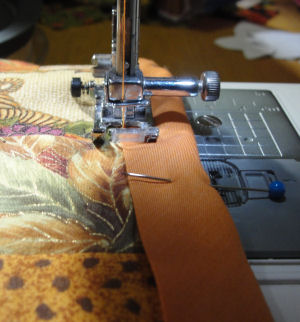If your fabrics are sheer or especially delicate, a bias tap bound seam may actually be too heavy. In this case, you may want to bind the seam using tricot, which is a lighter and more delicate fabric. It will work well with other fabrics of a similar weight.
To sew a tricot bound seam, cut a long piece of tricot about the width of the seam allowance. Fold this piece of tricot strip in half lengthwise and encase the raw edge of the seam allowance. Stitch along the edge of the tricot strip using either a zigzag or a straight stitch.
Remember to press your seam open before beginning. Also make sure the tricot you're using won't shrink when you wash the garment or item in question. When in doubt, pre-shrink your fabrics before you begin.
A small business devoted to the creation of custom sewing and knitting creations.Specializing in medieval, renaissance, and fantasy garb. Also handles weddings and graduations. We're based in Winnipeg, Manitoba, Canada, but we ship worldwide. Just ask!
Items posted on the main page are available for purchase unless otherwise indicated. If you'd like to purchase an item shown, send me a message indicating which country you live in and I'll quote you a shipping price. All payments are processed through Paypal only. If you're looking for a custom item, let me know the specifics and I'll quote you a total price. Custom items typically take 6 weeks to produce after payment is received. Keep this in mind when asking for custom orders.
Friday, August 14, 2015
Friday, August 7, 2015
Sewing a Bias Tape Bound Seam
Fabrics that fray so quickly and completely that they'll practically disappear on you typically benefit from an enclosed seam. The most common enclosed seam is a bias tape bound seam. this type of seam finish works well for easily frayed fabrics, fur, and unlined jackets that you need to give a professional look to. It's also fairly easy to pull off if you have some coordinating bias tape lying around. If you don't, head off to your local store and buy some. Make sure you've measured your seams and added up how much you'll need so you don't need to make a second run.
Now that you have your bias tape, it's time to enclose and finish your seam. Start by pressing your seam open. Then encase each raw edge with the bias tape, pinning carefully so you'll catch both sides of the tape and the fabric when you sew the seam. Stitch close to the folded edge of the bias tape, making sure you're not missing the tape on the other side. Once you stitch both sides of the seam, you're finished.
You can make your own bias tape, if you like. This is done by simply cutting long strips of fabric and folding and pressing so that it is folded just like bias tape. Examine a piece of bias tape to see how it's folded and you'll discover making your own out of whatever fabric you wish isn't hard.
Whether you make it or buy it, make sure to wash and dry the bias tape before you use it. Nothing is more irritating than having your bias tape shrink once you've already finished your garment. So always, always pre-shrink your bias tape.
Now that you have your bias tape, it's time to enclose and finish your seam. Start by pressing your seam open. Then encase each raw edge with the bias tape, pinning carefully so you'll catch both sides of the tape and the fabric when you sew the seam. Stitch close to the folded edge of the bias tape, making sure you're not missing the tape on the other side. Once you stitch both sides of the seam, you're finished.
You can make your own bias tape, if you like. This is done by simply cutting long strips of fabric and folding and pressing so that it is folded just like bias tape. Examine a piece of bias tape to see how it's folded and you'll discover making your own out of whatever fabric you wish isn't hard.
Whether you make it or buy it, make sure to wash and dry the bias tape before you use it. Nothing is more irritating than having your bias tape shrink once you've already finished your garment. So always, always pre-shrink your bias tape.
Subscribe to:
Posts (Atom)

